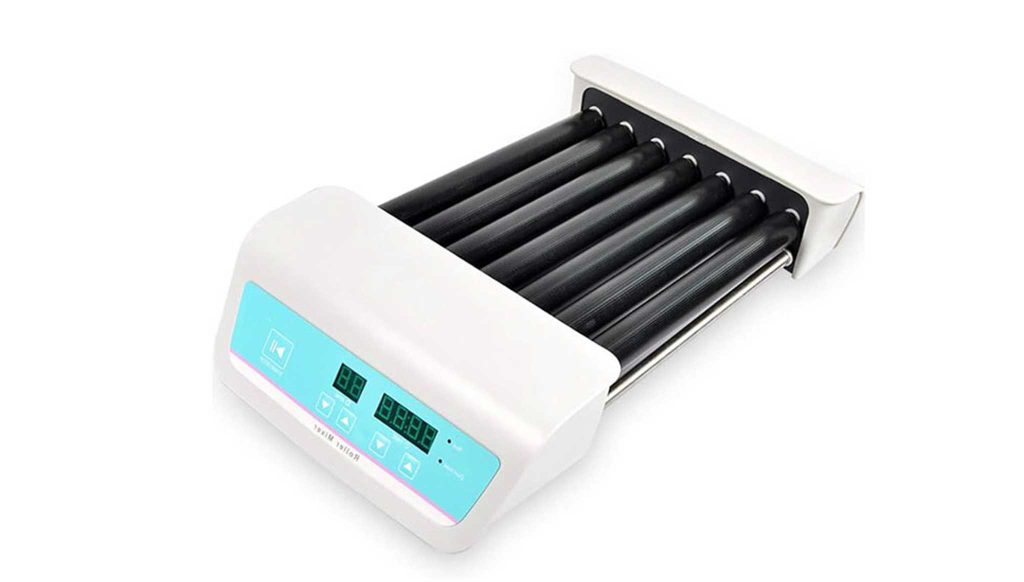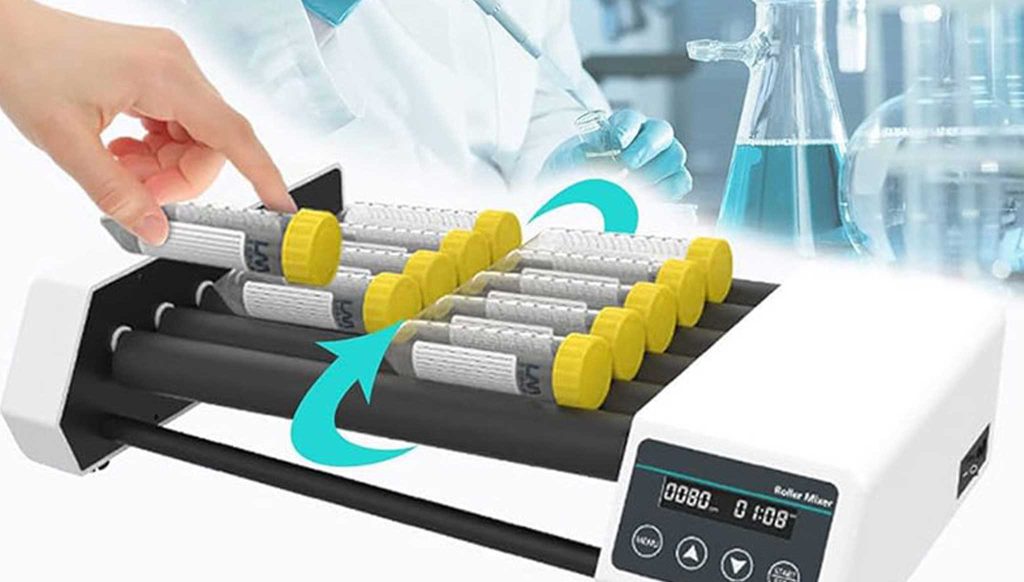Laboratory roller mixer is a device for mixing and preparing test samples. This device plays a very important role in the production and quality control of products with its proper features and performance.
In this article, we will review the features, uses and performance of the laboratory roller mixer to provide you with complete information about the laboratory equipment.
What is a laboratory roller mixer?
Laboratory roller mixer is one of the Laboratory equipment of research and industrial laboratories, which is used for mixing and testing different materials with different densities and viscosities, such as pastes, creams, powders and liquids. This device has two or more rollers that are parallel or crossed and can move at different speeds and pressures. These features allow for more precise adjustment of the mixing process. Laboratory roller mixer is used in various industries to prepare test samples and produce materials with special characteristics.
Mainly used in biochemistry and medicine, roller mixers provide gentle rocking and rolling motions and are ideal for mixing test tubes or bottles with various liquids such as liquid-solid suspensions, viscous materials, and blood samples.
Application of laboratory roller mixer
You should know that the laboratory roller mixer has various applications in various industries, including construction, chemical, food and pharmaceutical industries. This device is used to mix and test different materials with different densities and viscosities.
- In the construction industry, the laboratory roller mixer is used to prepare test samples of various construction materials such as concrete, asphalt and coating materials.
- In the chemical industry, the laboratory roller mixer is used to prepare and test various chemical formulations such as paints, adhesives, resins, and protective materials.
- In the food and pharmaceutical industries, laboratory roller mixers are used to prepare and test various substances such as pastes, creams, powders and medicines.
In general, the laboratory roller mixer is used in various industries to prepare test samples, produce materials with special characteristics, and perform quality and analytical tests, and it plays an important role in the production and quality control of products.
Advantages of laboratory roller mixer
The laboratory roller mixer, like any other laboratory device, has many advantages and features, including:
- Uniform mixing: due to the rotating movement of the rollers, the roller mixer is able to mix the materials uniformly and completely and prevent the formation of groups or globules of materials.
- Accurate temperature control: Some roller mixers have a cooling feature that makes it possible to accurately control the temperature in the mixing process and avoid overheating.
- Easy to use: laboratory roller mixers generally have simple and understandable controls that make it easy for users to use the device.
- Flexibility: These devices can be used to mix different types of materials, including liquids, powders, and pastes, and hence they are very flexible.
- High efficiency: Roller mixers are highly efficient due to their proper design and powerful motors and can be used continuously for long periods of time.
Disadvantages of laboratory roller mixer
The disadvantages of using a roller mixer are:
- Volume Limits: Depending on the size and type of roller mixer, there may be limits on the volume of materials it can mix.
- High cost: Some types of laboratory roller mixers have a high cost, which may be difficult for some users to obtain.
- Need for maintenance and repairs: Like any other equipment, laboratory roller mixers require periodic maintenance and repairs, which may be costly and time-consuming.
- Energy consumption: some laboratory roller mixers may have relatively high energy consumption, which can lead to additional costs for users.
Types of laboratory roller mixers
There are different types of laboratory roller mixers, including:
- Grout roller mixer: This type of roller mixer has two rollers that are parallel to each other. This device is used for accurate and uniform mixing of materials with different densities and viscosities.
- Three-gap roller mixer: This type of roller mixer has three rollers that are placed parallel or crossed. This device is used to mix materials with a larger volume and also to prepare test samples with a larger volume.
- Roller mixer with cooling system: Some roller mixers have cooling systems that make it possible to control the temperature in the mixing process and prevent excess heat.
Each of these types of laboratory roller mixers have their own characteristics and applications and are selected depending on different laboratory and industrial needs.
Laboratory roller mixer structure
The structure of laboratory roller mixer is as follows:
- Roller: Laboratory roller mixer has two or more rollers that are placed parallel or crossed.
- Motor: The rollers are moved by a powerful motor whose speed, power and pressure can be adjusted.
- Cooling system: Some roller mixers have cooling systems to prevent overheating.
- Control panel: A control panel that allows you to adjust the speed and pressure of the rollers.
The structure of laboratory roller mixer varies depending on its model, class and application.
How laboratory roller mixer works
The operation of the roller mixer mainly depends on two factors: 1. The rotation speed of the roller mixer, 2. The pressure on the materials
By adjusting these two factors, different mixtures with different characteristics can be prepared. Also, some roller mixers have cooling systems that make it possible to control the temperature in the mixing process and prevent overheating.
In general, the laboratory roller mixer’s performance is based on the rotation of the rollers and the application of appropriate pressure on the materials to prepare uniform mixtures according to the experimental needs.
Types of laboratory roller mixer classes
The laboratory roller mixer is in the following classes:
- Capacity: Classification of roller mixers based on the capacity of mixing materials with low, medium and large capacity.
- Rotation speed: Roller mixer division based on roller rotation speed with low, medium and high rotation speed.
- Cooling ability: division of roller mixers based on low, medium and high cooling ability.
This classification of roller mixers helps users to choose the best one to meet their needs.
The difference between a roller mixer and a laboratory shaker
All types of laboratory shakers consist of a plate that is the place to place containers containing samples. Laboratory shakers are used to mix samples inside laboratory glass containers such as volumetric flasks, Beshr and Erlenmeyer flasks. If the hematology roller mixers are suitable for placing laboratory tubes containing samples. The tubes are placed in the space between the two rollers and the sample will be homogenized by the movement of the rollers.

Summery
Laboratory roller mixer is a vital device in research and industrial laboratories, which is used to prepare test samples and produce materials with special characteristics. This device is of special importance; Because it provides the possibility to adjust the speed and pressure of the rollers as well as the temperature. To buy and get the price of the day, contact the experts of the root site.




